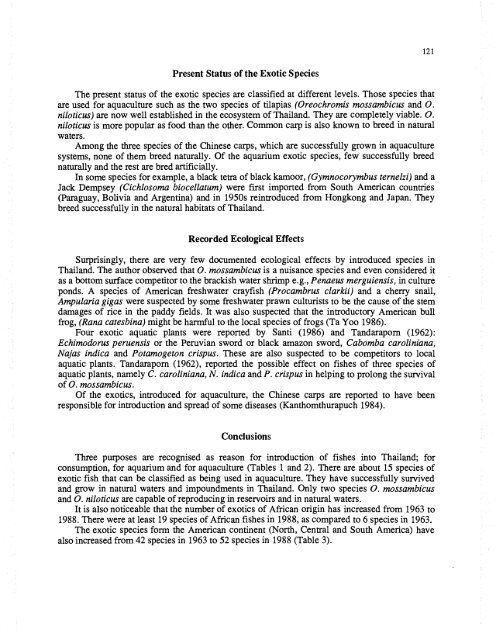Exotic Aquatic Organisms - International Development Research ...
Exotic Aquatic Organisms - International Development Research ...
Exotic Aquatic Organisms - International Development Research ...
Create successful ePaper yourself
Turn your PDF publications into a flip-book with our unique Google optimized e-Paper software.
Present Status of the <strong>Exotic</strong> Species<br />
The present status of the exotic species are classified at different levels. Those species that<br />
are used for aquaculture such as the two species of tilapias (Oreochromis mossambicus and 0.<br />
niloticus) are now well established in the ecosystem of Thailand. They are completely viable. 0.<br />
niloticus is more popular as food than the other. Common carp is also known to breed in natural<br />
waters.<br />
Among the three species of the Chinese carps, which are successfully grown in aquaculture<br />
systems, none of them breed naturally. Of the aquarium exotic species, few successfully breed<br />
naturally and the rest are bred artificially.<br />
In some species for example, a black tetra of black kamoor, (Gymnocorymbus terneizi) and a<br />
Jack Dempsey (Cichiosoma biocellatum) were first imported from South American countries<br />
(Paraguay, Bolivia and Argentina) and in 1950s reintroduced from Hongkong and Japan. They<br />
breed successfully in the natural habitats of Thailand.<br />
Recorded Ecological Effects<br />
Surprisingly, there are very few documented ecological effects by introduced species in<br />
Thailand. The author observed that 0. mossarnbicus is a nuisance species and even considered it<br />
as a bottom surface competitor to the brackish water shrimp e.g., Penaeus merguiensis, in culture<br />
ponds. A species of American freshwater crayfish (Procambrus clarkii) and a cherry snail,<br />
Ampularia gigas were suspected by some freshwater prawn culturists to be the cause of the stem<br />
damages of rice in the paddy fields. It was also suspected that the introductory American bull<br />
frog, (Rana catesbina) might be harmful to the local species of frogs (Ta Yoo 1986).<br />
Four exotic aquatic plants were reported by Santi (1986) and Tandaraporn (1962):<br />
Echimodorus peruensis or the Peruvian sword or black amazon sword, Cabomba caroliniana,<br />
Najas indica and Potamogeton crispus. These are also suspected to be competitors to local<br />
aquatic plants. Tandaraporn (1962), reported the possible effect on fishes of three species of<br />
aquatic plants, namely C. caroliniana, N. indica and P. crispus in helping to prolong the survival<br />
of 0. mossambicus.<br />
Of the exotics, introduced for aquaculture, the Chinese carps are reported to have been<br />
responsible for introduction and spread of some diseases (Kanthomthurapuch 1984).<br />
Conclusions<br />
Three purposes are recognised as reason for introduction of fishes into Thailand; for<br />
consumption, for aquarium and for aquaculture (Tables 1 and 2). There are about 15 species of<br />
exotic fish that can be classified as being used in aquaculture. They have successfully survived<br />
and grow in natural waters and impoundments in Thailand. Only two species 0. mossambicus<br />
and 0. niloticus are capable of reproducing in reservoirs and in natural waters.<br />
It is also noticeable that the number of exotics of African origin has increased from 1963 to<br />
1988. There were at least 19 species of African fishes in 1988, as compared to 6 species in 1963.<br />
The exotic species form the American continent (North, Central and South America) have<br />
also increased from 42 species in 1963 to 52 species in 1988 (Table 3).<br />
121

















